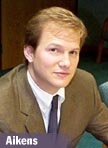Mapping the Assets: a systematic partner search in Connecticut
Originally published in Current, July 5, 1999
By Steve Behrens
 Many
public TV and radio stations were born out of civic alliances, and live by
them today, but few are developing new ties for the DTV era so deliberately
and aggressively as Connecticut Public Television & Radio (CPT&R) in Hartford.
Many
public TV and radio stations were born out of civic alliances, and live by
them today, but few are developing new ties for the DTV era so deliberately
and aggressively as Connecticut Public Television & Radio (CPT&R) in Hartford.
"Instead of focusing on the hardware, we decided to focus on what we could do with the new technology," says Steve Futernick, senior v.p. for community development.
Multicasting was the new ability that grabbed Jerry Franklin, president of the nonprofit state network, when he began thinking about DTV. "Having the ability to have more than one channel--I saw tremendous opportunity for us in Connecticut."
Franklin thought of former PBS President Larry Grossman's persistent advocacy of a "grand alliance" of cultural institutions with public TV, and asked Grossman, who served on the network's board, to chair the board's Strategic Development Committee.
"What was astonishing was how enthusiastic and eager everyone was to participate," says Grossman. Connecticut's secretary of state wants to boost citizen participation. A group at Yale wants to disseminate its research. "It's not a matter of Connecticut Public Television letting them in. It's a matter of letting them shape this in their own interest."
 The
network later hired project director Scott Aikens, developer of the E-Democracy
web service for Minnesota voters and, more recently, a "virtual think tank"
used in Britain for online discussion of economic policy. Aikens runs what
they call "Mapping the Assets."
The
network later hired project director Scott Aikens, developer of the E-Democracy
web service for Minnesota voters and, more recently, a "virtual think tank"
used in Britain for online discussion of economic policy. Aikens runs what
they call "Mapping the Assets."
The "assets" that CPT&R is surveying are the potential program content and other capabilities of the state's institutions, nonprofit, government and otherwise. Not the least are the state network's forthcoming digital assets, which attract partners and enable it to convene discussions.
To support Mapping the Assets, CPT&R raised more than $200,000 from the Ford, Markle and Horace W. Goldsmith foundations. By the end of the year, Franklin predicts, the network will be completing business plans for several self-supporting pilot projects.
"A pretty broad and deep partnership" of institutions is investing time and hopes in the initiative, says Elaine Zimmerman, executive director of the Connecticut Commission on Children and a member of Grossman's committee. "People are gambling because they have very high faith in this."
Zimmerman herself wants to bring DTV technology to the Parent Leadership Training Institute, a 20-session course that now trains 100 parents a year how to be activists for children. A related project with the Commission on Children will combine its training for daycare providers with CPT&R's daycare training project, and adding the Barney & Friends brand name, says Aikens. Training sessions may be captured in streaming video for the Internet. (Putting them on videotape would be "kind of old-fashioned," Aikens says.)
The first civic collaboration to get going, according to Franklin, is the Connecticut Network, a state version of C-SPAN, launched last March with cable operators, the community college system and a nonprofit called the Public Affairs Network. It now transmits from robotic cameras in the state legislature four hours a day, aiming for 24.
Another, starting in the fall, will be a workplace skills training project backed by United Illuminating, the state's largest power company, which will use various distance learning technologies. Franklin thinks it will evolve into one of Connecticut PTV's DTV multicast channels. "We've made the decision to get into the business of delivering training material," he says, "And someone will pay us for that service."
The terminology and some of the thinking behind Mapping the Assets come from the writings of John L. McKnight of Northwestern University's Institute for Policy Research.
While most social activitists start work by surveying a community's needs and gaps, McKnight suggests looking first at strengths, says Peter Block, a community development consultant who serves on Grossman's committee. "Capacities and strengths are the way communities get built," says Block. "The focus is different: who are the people? What are they good at? What do they care about? How do we bring them together?"
"When you go around to see what are the gaps, you get an empty drawer," comments Zimmerman, who also reads McKnight. "When you look at assets, you find out all the jewels in the community ... and then the opportunity is to figure out how you're going to string together those jewels."
"What gives me hope about what they're doing with Connecticut Public Television," says Block, "is the chance to change the mindset about the role of television." While commercial broadcasters "profit from the wounds of the culture" by exploiting its worst news, he says, pubcasters can take a constructive role in the community.
But he fears the Connecticut project is atypical. "It worries me," Block says, "that public TV is focused on being just another commercial station."
![]()
![]() Outside links:
Connecticut Public TV & Radio's Mapping
the Assets web site, and Prof.
John L. McKnight's page at Northwestern University's Institute for Policy
Research.
Outside links:
Connecticut Public TV & Radio's Mapping
the Assets web site, and Prof.
John L. McKnight's page at Northwestern University's Institute for Policy
Research.
![]()
Current
The newspaper about public television and radio
in the United States
A service of Current Publishing Committee, Takoma Park, Md.
E-mail: web
301-270-7240
Copyright 1999
